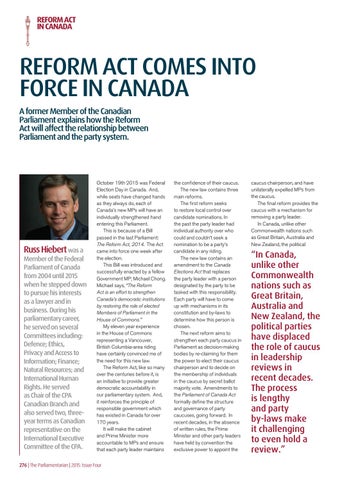REFORM ACT in Canada
Reform Act comes into force in Canada A former Member of the Canadian Parliament explains how the Reform Act will affect the relationship between Parliament and the party system.
Russ Hiebert was a
Member of the Federal Parliament of Canada from 2004 until 2015 when he stepped down to pursue his interests as a lawyer and in business. During his parliamentary career, he served on several Committees including: Defence; Ethics, Privacy and Access to Information; Finance; Natural Resources; and International Human Rights. He served as Chair of the CPA Canadian Branch and also served two, threeyear terms as Canadian representative on the International Executive Committee of the CPA.
October 19th 2015 was Federal Election Day in Canada. And, while seats have changed hands as they always do, each of Canada’s new MPs will have an individually strengthened hand entering this Parliament. This is because of a Bill passed in the last Parliament: The Reform Act, 2014. The Act came into force one week after the election. This Bill was introduced and successfully enacted by a fellow Government MP, Michael Chong. Michael says, “The Reform Act is an effort to strengthen Canada’s democratic institutions by restoring the role of elected Members of Parliament in the House of Commons.” My eleven year experience in the House of Commons representing a Vancouver, British Columbia-area riding have certainly convinced me of the need for this new law. The Reform Act, like so many over the centuries before it, is an initiative to provide greater democratic accountability in our parliamentary system. And, it reinforces the principle of responsible government which has existed in Canada for over 170 years. It will make the cabinet and Prime Minister more accountable to MPs and ensure that each party leader maintains
276 | The Parliamentarian | 2015: Issue Four
the confidence of their caucus. The new law contains three main reforms. The first reform seeks to restore local control over candidate nominations. In the past the party leader had individual authority over who could and couldn’t seek a nomination to be a party’s candidate in any riding. The new law contains an amendment to the Canada Elections Act that replaces the party leader with a person designated by the party to be tasked with this responsibility. Each party will have to come up with mechanisms in its constitution and by-laws to determine how this person is chosen. The next reform aims to strengthen each party caucus in Parliament as decision-making bodies by re-claiming for them the power to elect their caucus chairperson and to decide on the membership of individuals in the caucus by secret ballot majority vote. Amendments to the Parliament of Canada Act formally define the structure and governance of party caucuses, going forward. In recent decades, in the absence of written rules, the Prime Minister and other party leaders have held by convention the exclusive power to appoint the
caucus chairperson, and have unilaterally expelled MPs from the caucus. The final reform provides the caucus with a mechanism for removing a party leader. In Canada, unlike other Commonwealth nations such as Great Britain, Australia and New Zealand, the political
“In Canada, unlike other Commonwealth nations such as Great Britain, Australia and New Zealand, the political parties have displaced the role of caucus in leadership reviews in recent decades. The process is lengthy and party by-laws make it challenging to even hold a review.”
